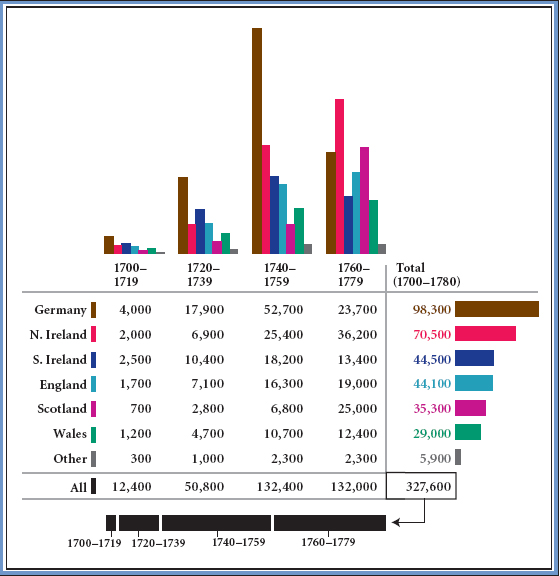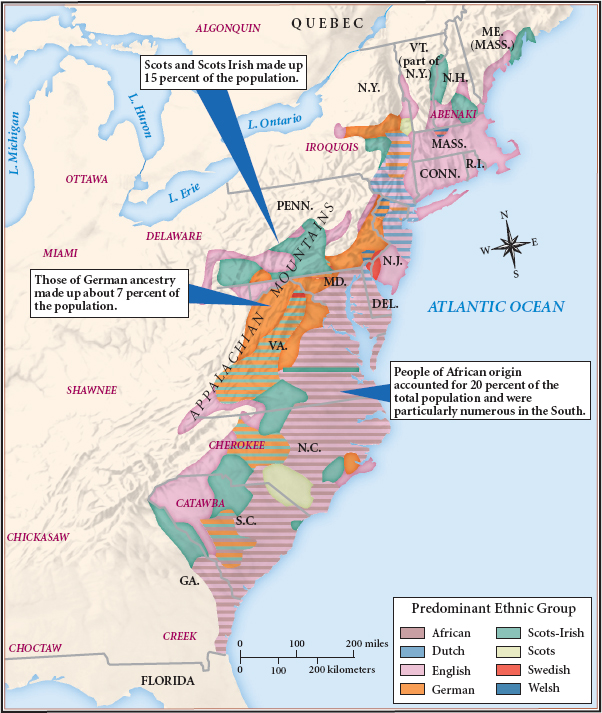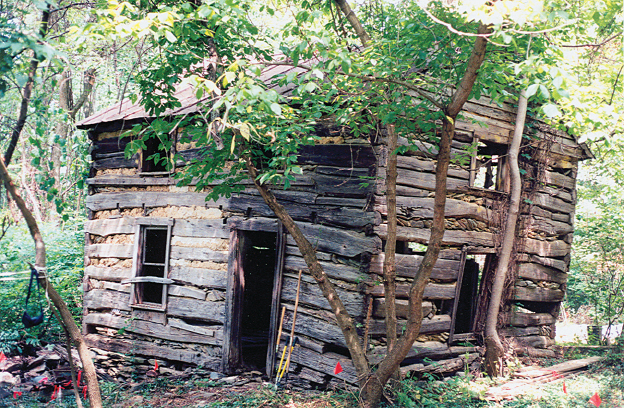America’s History: Printed Page 122
America: A Concise History: Printed Page 105
America’s History: Value Edition: Printed Page 102
Cultural Diversity

The Middle Atlantic colonies were not a melting pot. Most European migrants held tightly to their traditions, creating a patchwork of ethnically and religiously diverse communities (Figure 4.2). In 1748, a Swedish traveler counted no fewer than twelve religious denominations in Philadelphia, including Anglicans, Baptists, Quakers, Swedish and German Lutherans, Mennonites, Scots-Irish Presbyterians, and Roman Catholics.
Migrants preserved their cultural identity by marrying within their ethnic groups. A major exception was the Huguenots, Calvinists who had been expelled from Catholic France in the 1680s and resettled in Holland, England, and the British colonies. Huguenots in American port cities such as Boston, New York, and Charleston quickly lost their French identities by intermarrying with other Protestants. More typical were the Welsh Quakers in Chester County, Pennsylvania: 70 percent of the children of the original Welsh migrants married other Welsh Quakers, as did 60 percent of the third generation.
In Pennsylvania and western New Jersey, Quakers shaped the culture because of their numbers, wealth, and social cohesion. Most Quakers came from English counties with few landlords and brought with them traditions of local village governance, popular participation in politics, and social equality. But after 1720, the growth of German and Scots-Irish populations challenged their dominance.

The German Influx The Quaker vision of a “peaceable kingdom” attracted 100,000 German migrants who had fled their homelands because of military conscription, religious persecution, and high taxes. First to arrive, in 1683, were the Mennonites, religious dissenters drawn by the promise of freedom of worship. In the 1720s, a larger wave of German migrants arrived from the overcrowded villages of southwestern Germany and Switzerland. “Wages were far better” in Pennsylvania, Heinrich Schneebeli reported to his friends in Zurich, and “one also enjoyed there a free unhindered exercise of religion.” A third wave of Germans and Swiss — nearly 40,000 strong — landed in Philadelphia between 1749 and 1756. To help pay the costs of the expensive trip from the Rhine Valley, German immigrants pioneered the redemptioner system, a flexible form of indentured servitude that allowed families to negotiate their own terms upon arrival. Families often indentured one or more children while their parents set up a household of their own.
Germans soon dominated many districts in eastern Pennsylvania, and thousands more moved down the fertile Shenandoah Valley into the western backcountry of Maryland, Virginia, and the Carolinas (Map 4.2). Many migrants preserved their cultural identity by settling in German-speaking Lutheran and Reformed communities that endured well beyond 1800. A minister in North Carolina admonished young people “not to contract any marriages with the English or Irish,” arguing that “we owe it to our native country to do our part that German blood and the German language be preserved in America.”

These settlers were willing colonial subjects of Britain’s German-born and German-speaking Protestant monarchs, George I (r. 1714–1727) and George II (r. 1727–1760). They generally avoided politics except to protect their cultural practices; for example, they insisted that married women have the legal right to hold property and write wills, as they did in Germany.
Scots-Irish Settlers Migrants from Ireland, who numbered about 115,000, were the most numerous of the incoming Europeans. Some were Irish and Catholic, but most were Scots and Presbyterian, the descendants of the Calvinist Protestants sent to Ireland during the seventeenth century to solidify English rule there. Once in Ireland, the Scots faced hostility from both Irish Catholics and English officials and landlords. The Irish Test Act of 1704 restricted voting and office holding to members of the Church of England, English mercantilist regulations placed heavy import duties on linens made by Scots-Irish weavers, and farmers paid heavy taxes. This persecution made America seem desirable. “Read this letter, Rev. Baptist Boyd,” a migrant to New York wrote back to his minister, “and tell all the poor folk of ye place that God has opened a door for their deliverance … all that a man works for is his own; there are no revenue hounds to take it from us here.”
Lured by such reports, thousands of Scots-Irish families sailed for the colonies. By 1720, most migrated to Philadelphia, attracted by the religious tolerance there. Seeking cheap land, they moved to central Pennsylvania and to the fertile Shenandoah Valley to the south. Governor William Gooch of Virginia welcomed the Scots-Irish presence to secure “the Country against the Indians.” An Anglican planter, however, thought them as dangerous as “the Goths and Vandals of old” had been to the Roman Empire. Like the Germans, the Scots-Irish retained their culture, living in ethnic communities and holding firm to the Presbyterian Church.
IDENTIFY CAUSES
Question
What attracted German and Scots-Irish migrants to Pennsylvania in such large numbers?